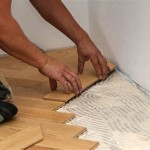Laying Sheet Vinyl Flooring In Bathroom: A Comprehensive Guide
Sheet vinyl flooring is a popular choice for bathrooms due to its water resistance, ease of maintenance, and affordability. When compared to other flooring options like tile or hardwood, sheet vinyl offers a seamless surface that minimizes the risk of water damage, a crucial consideration in a moisture-prone environment like a bathroom. The installation process, while demanding attention to detail, is manageable for many DIY enthusiasts, allowing for cost savings. This article provides a comprehensive guide to laying sheet vinyl flooring in a bathroom, covering preparation, installation, and post-installation considerations.
Preparing the Subfloor for Vinyl Installation
The success of any flooring installation hinges on the quality of the subfloor. In the context of sheet vinyl, a smooth, level, and clean subfloor is paramount. Imperfections will telegraph through the vinyl, impacting its appearance and potentially compromising its longevity. This section outlines the critical steps involved in preparing the subfloor.
Assessment and Repair: The first step is a thorough assessment of the existing subfloor. This involves identifying any issues such as cracks, holes, unevenness, or loose sections. Common subfloor materials in bathrooms include plywood, concrete, and existing vinyl. Each requires specific attention during the assessment phase.
For plywood subfloors, check for water damage, warping, or delamination. Damaged sections should be replaced with new plywood of the same thickness. Screws, not nails, provide a more secure and durable fastening. Ensure the screws are countersunk to avoid creating bumps on the surface.
Concrete subfloors require checking for cracks and unevenness. Small cracks can be filled with a concrete patching compound. Larger cracks may indicate structural issues requiring professional assessment. Self-leveling concrete compounds are effective for addressing unevenness. These compounds are mixed according to the manufacturer's instructions and poured onto the floor, spreading evenly to create a level surface.
If existing vinyl flooring is present, evaluate its condition. If it is securely bonded, smooth, and free of significant damage, it may be possible to install the new sheet vinyl directly over it. However, if the existing vinyl is peeling, has deep gouges, or is otherwise compromised, it must be removed. Use a scraper and, if necessary, a heat gun to soften the adhesive. Always wear appropriate safety gear, including gloves and a respirator, when removing old vinyl flooring due to potential asbestos content in older materials. Proper disposal according to local regulations is crucial.
Cleaning and Leveling: Once repairs are complete, thoroughly clean the subfloor. Remove any debris, dust, or adhesive residue. A vacuum cleaner with a brush attachment is effective for removing loose particles. For stubborn adhesive residue, use a specialized adhesive remover recommended for the subfloor material. Follow the manufacturer's instructions carefully, and ensure adequate ventilation.
After cleaning, inspect the subfloor again for any remaining imperfections. Small imperfections, such as nail holes or minor dips, can be filled with a patching compound designed for flooring. Apply the compound using a putty knife, ensuring it is flush with the surrounding surface. Allow the compound to dry completely according to the manufacturer's instructions before sanding it smooth.
Sanding: Sanding is essential for creating a smooth, even surface. Use a floor sander with a fine-grit sandpaper (100-120 grit) to gently sand the entire subfloor. Pay particular attention to patched areas to ensure they blend seamlessly with the surrounding surface. Vacuum the subfloor thoroughly after sanding to remove any remaining dust particles.
Installing the Sheet Vinyl Flooring
With the subfloor properly prepared, the next step is the installation of the sheet vinyl flooring. This process involves careful measurement, cutting, and adhesion to ensure a seamless and durable result. Precision and patience are key to achieving a professional-looking installation.
Measurement and Template Creation: Accurately measuring the bathroom is critical. Measure the length and width of the room at the longest points. It is advisable to add a few extra inches to each dimension to allow for trimming and adjustments. Irregular shapes, such as around toilets and vanities, require a more precise approach. One effective method is to create a template using builder's paper or cardboard. Lay the paper or cardboard on the floor and carefully trace the outline of the room, including any obstacles. Transfer this template onto the sheet vinyl for cutting.
Cutting the Vinyl Sheet: Place the sheet vinyl on a clean, flat surface. Use the template (if created) or the measurements taken to mark the cutting lines on the vinyl. Employ a sharp utility knife with a new blade for clean, precise cuts. Multiple shallow cuts are preferable to a single deep cut, as this reduces the risk of tearing or damaging the vinyl. When cutting around obstacles, such as pipes or toilet flanges, make relief cuts to allow the vinyl to conform to the shape. Leave a slight overlap initially, as it is easier to trim excess material later.
Dry Fitting: Before applying adhesive, conduct a dry fit of the vinyl sheet. This involves positioning the vinyl in the bathroom to ensure it fits correctly and that all cuts are accurate. Make any necessary adjustments by trimming excess material. Pay close attention to the edges, ensuring they align properly with the walls. A small gap (approximately 1/8 inch) between the vinyl and the wall is recommended to allow for expansion and contraction due to temperature changes.
Adhesive Application: Once satisfied with the fit, carefully roll back half of the vinyl sheet. Apply adhesive to the exposed subfloor using a notched trowel. The type of adhesive and the notch size of the trowel will depend on the manufacturer's recommendations for the specific vinyl sheet being used. Follow these recommendations closely to ensure proper adhesion. Spread the adhesive evenly, avoiding pooling or excessive build-up. Allow the adhesive to tack up according to the manufacturer's instructions before rolling the vinyl back into place. Repeat the process for the other half of the vinyl sheet.
Rolling and Seaming: After applying the adhesive, use a floor roller to press the vinyl firmly onto the subfloor. Start at the center of the room and work outwards, ensuring complete contact between the vinyl and the adhesive. This process removes air bubbles and ensures a strong bond. Pay particular attention to the edges and corners. If seams are necessary due to the size of the room, use a seam roller to create a tight, invisible seam. Seam sealers are available to further waterproof the seam and prevent lifting.
Post-Installation Considerations and Maintenance
Following the installation, proper care and maintenance are essential to prolong the life of the sheet vinyl flooring and maintain its appearance. This section covers post-installation steps and ongoing maintenance practices.
Sealing and Trimming: After the adhesive has fully cured (typically 24-48 hours, according to the manufacturer's instructions), trim any excess vinyl along the edges using a sharp utility knife and a straight edge. A clean, precise cut is essential for a professional finish. Apply a bead of silicone caulk around the perimeter of the room where the vinyl meets the walls. This creates a waterproof seal that prevents water from seeping under the flooring. Choose a caulk that is specifically designed for bathrooms and is mildew-resistant.
Curing and Initial Cleaning: Allow the adhesive to fully cure before placing heavy furniture on the flooring. Avoid washing the floor for at least 24 hours after installation to allow the adhesive to fully bond. After the curing period, clean the floor with a mild detergent and water. Avoid using harsh chemicals or abrasive cleaners, as these can damage the vinyl surface. A damp mop or sponge is usually sufficient for routine cleaning.
Ongoing Maintenance: Regular cleaning is essential for maintaining the appearance of sheet vinyl flooring. Sweep or vacuum the floor regularly to remove dirt and debris. Clean spills immediately to prevent staining. Use a pH-neutral cleaner specifically designed for vinyl floors. Avoid using ammonia-based cleaners, bleach, or abrasive scouring pads, as these can dull the finish and damage the surface. For stubborn stains, try a specialized vinyl floor cleaner or a mixture of baking soda and water.
Protection and Prevention: Protect the vinyl flooring from scratches and dents by using floor protectors under furniture legs. Avoid dragging heavy objects across the floor. Place mats or rugs in high-traffic areas to reduce wear and tear. Consider using a sealant or polish specifically designed for vinyl floors to provide added protection and enhance the shine. Follow the manufacturer's instructions for application and maintenance of these products.
Addressing Potential Issues: Over time, sheet vinyl flooring may experience wear and tear. Small scratches can often be buffed out with a soft cloth. Deeper scratches or gouges may require professional repair. In cases of severe damage, such as tears or punctures, the affected section of the vinyl may need to be replaced. Contact a flooring professional for assistance with more complex repairs.
By meticulously following these guidelines, a durable, aesthetically pleasing, and water-resistant sheet vinyl floor can be successfully installed in any bathroom. While requiring attention to detail and adherence to the manufacturer's specifications, the resulting installation offers a practical and cost-effective flooring solution for this demanding environment.

How To Install Sheet Vinyl Floor Decor Adventures

How To Install Sheet Vinyl Floor Decor Adventures

How To Install Sheet Vinyl Floor Decor Adventures

How To Install Sheet Vinyl Flooring

How To Install Vinyl Sheet Flooring A Erfly House

How To Install Vinyl Sheet Flooring A Erfly House

How To Lay Vinyl Sheet In A Bathroom Flooring Factory

Diy How To Lay Vinyl Or Lino Flooring

How To Install Sheet Vinyl Floor Decor Adventures

How To Install Sheet Vinyl Lino Flooring In A Bathroom Easy Step By Diy Guide
Related Posts








